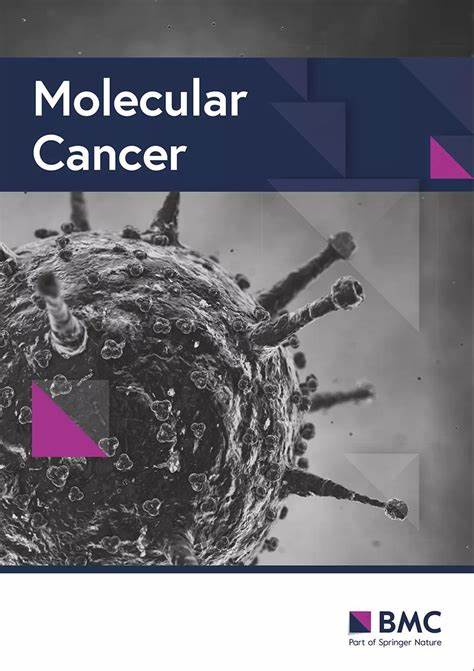Distant origin of glioblastoma recurrence: neural stem cells in the subventricular zone serve as a source of tumor reconstruction after primary resection
IF 27.7
1区 医学
Q1 BIOCHEMISTRY & MOLECULAR BIOLOGY
引用次数: 0
Abstract
Glioblastoma (GBM) is the most aggressive and common type of primary malignant brain cancer in adults. GBM often recurs locally near the resection cavity (RC) following the surgical removal of primary tumors. Recent research has reported that neural stem cells (NSCs) in the subventricular zone (SVZ) harboring cancer-driving mutations serve as the cells of origin for human GBM. However, the pathological role of tumor-initiating NSCs in the SVZ in tumor recurrence remains to be elucidated. Here, we explore the potential contribution of mutation-harboring NSCs in the SVZ to tumor recurrence around the RC following surgical resection. Our hypothesis emerged from performing deep sequencing of longitudinal tissues from 10 patients with GBM, including (i) tumor-free SVZ tissue, (ii) primary tumor tissue, (iii) recurrent tumor tissue, and (iv) blood. As a result of this sequencing, we observed evidence suggesting that recurrent tumors show genetic links to the SVZ in 60% (6/10) of patients, which are distinct from the primary tumors. Using a genome-edited mouse model, we further identified that mutation-harboring NSCs appeared to migrate to the RC through the aberrant growth of oligodendrocyte progenitor cells, potentially contributing to the reconstruction of high-grade malignant gliomas in the RC. This process was associated with the CXCR4/CXCL12 axis, as supported by RNA sequencing data from human recurrent GBM. Taken together, our findings suggest that NSCs in human SVZ tissue may play a role in GBM recurrence, potentially highlighting a novel distant contributor of recurrence.胶质母细胞瘤复发的远端起源:脑室下区的神经干细胞是原发切除术后肿瘤重建的源头
胶质母细胞瘤(GBM)是成人中最具侵袭性和最常见的原发性恶性脑癌。在原发肿瘤手术切除后,GBM经常在切除腔附近局部复发。最近的研究报道,脑室下区(SVZ)的神经干细胞(NSCs)携带癌症驱动突变,是人类GBM的起源细胞。然而,SVZ中肿瘤启动性NSCs在肿瘤复发中的病理作用仍有待阐明。在这里,我们探讨了SVZ中携带突变的NSCs对手术切除后RC周围肿瘤复发的潜在贡献。我们的假设来自于对10例GBM患者的纵向组织进行深度测序,包括(i)无肿瘤SVZ组织,(ii)原发肿瘤组织,(iii)复发肿瘤组织和(iv)血液。通过测序,我们观察到有证据表明,60%(6/10)的患者复发性肿瘤与SVZ有遗传联系,这与原发肿瘤不同。通过基因组编辑的小鼠模型,我们进一步发现,携带突变的NSCs似乎通过少突胶质细胞祖细胞的异常生长迁移到RC,可能有助于RC中高级别恶性胶质瘤的重建。这一过程与CXCR4/CXCL12轴相关,这一点得到了人类复发性GBM的RNA测序数据的支持。综上所述,我们的研究结果表明,人类SVZ组织中的NSCs可能在GBM复发中发挥作用,潜在地突出了复发的一个新的远源因素。
本文章由计算机程序翻译,如有差异,请以英文原文为准。
求助全文
约1分钟内获得全文
求助全文
来源期刊

Molecular Cancer
医学-生化与分子生物学
CiteScore
54.90
自引率
2.70%
发文量
224
审稿时长
2 months
期刊介绍:
Molecular Cancer is a platform that encourages the exchange of ideas and discoveries in the field of cancer research, particularly focusing on the molecular aspects. Our goal is to facilitate discussions and provide insights into various areas of cancer and related biomedical science. We welcome articles from basic, translational, and clinical research that contribute to the advancement of understanding, prevention, diagnosis, and treatment of cancer.
The scope of topics covered in Molecular Cancer is diverse and inclusive. These include, but are not limited to, cell and tumor biology, angiogenesis, utilizing animal models, understanding metastasis, exploring cancer antigens and the immune response, investigating cellular signaling and molecular biology, examining epidemiology, genetic and molecular profiling of cancer, identifying molecular targets, studying cancer stem cells, exploring DNA damage and repair mechanisms, analyzing cell cycle regulation, investigating apoptosis, exploring molecular virology, and evaluating vaccine and antibody-based cancer therapies.
Molecular Cancer serves as an important platform for sharing exciting discoveries in cancer-related research. It offers an unparalleled opportunity to communicate information to both specialists and the general public. The online presence of Molecular Cancer enables immediate publication of accepted articles and facilitates the presentation of large datasets and supplementary information. This ensures that new research is efficiently and rapidly disseminated to the scientific community.
 求助内容:
求助内容: 应助结果提醒方式:
应助结果提醒方式:


